Influence of Magnetron Sputtering-Deposited Niobium Nitride Coating and Its Thermal Oxidation on the Properties of AISI 316L Steel in Terms of Its Medical Applications
Abstract
:1. Introduction
2. Materials and Methods
2.1. Specimen Preparation
2.2. Microstructural and Hardness Analysis
2.3. Phase and Chemical Composition Analysis
2.4. Surface Topography Analysis
2.5. Corrosion Measurements
2.6. Bioactivity and Wettability Analysis
3. Results and Discussion
4. Conclusions
- Calcium phosphates have formed on AISI 316L steel, as well as on NbN and NbN + Nb2O5 coatings after soaking in SBF solution, with the NbN coating and the oxidised NbN coating showing a Ca/P ratio closest to that of hydroxyapatite, which indicates good bioactivity of both the produced coatings.
- The sample with the oxidised NbN coating showed the best corrosion resistance in Ringer’s solution. Pitting corrosion was observed for each of the samples tested, while the AISI 316L sample without coating also showed crevice corrosion. For the NbN and the NbN + Nb2O5 coatings, a clear improvement in crevice corrosion resistance was observed.
- The formation of an Nb2O5 surface layer resulted in an increase in hydrophilic properties compared to the non-oxidised NbN coating. The contact angle of the oxidised coating was also lower compared to steel in its initial state, which can positively improve the osteointegration of bone tissue with the surface of the NbN + Nb2O5 coating.
- AISI 316L steel with an Nb2O5 top layer produced on NbN coating has the greatest potential for biomedical applications given its best combination of properties such as high corrosion resistance, bioactivity, surface hydrophilicity and increased hardness compared to AISI 316L steel.
Author Contributions
Funding
Institutional Review Board Statement
Informed Consent Statement
Data Availability Statement
Conflicts of Interest
References
- Wang, W.; Ji, L.; Li, H.; Zhou, H.; Chen, J. Self-organized formation of nano-multilayer structure in the carbon-copper thin film during reactive magnetron sputtering deposition process. J. Alloys Compd. 2017, 722, 242–249. [Google Scholar] [CrossRef]
- Zhou, Z.; Song, Q.; Xu, Y.; Liang, H.; Zhang, M.; Zhang, B.; Yan, P. Magnetron sputtering deposited large-scale Weyl semimetal THz detector. Infrared Phys. Technol. 2022, 121, 104060. [Google Scholar] [CrossRef]
- Yang, Q.; Seo, D.Y.; Zhao, L.R. Multilayered coatings with alternate pure Ti and TiN/CrN superlattice. Surf. Coat. Technol. 2004, 177–178, 204–208. [Google Scholar] [CrossRef]
- Li, Y.; Xie, M.; Sun, Q.; Xu, X.; Fan, X.; Zhang, G.; Li, H.; Zhu, M. The effect of atmosphere on the tribological behavior of magnetron sputtered MoS2 coatings. Surf. Coat. Technol. 2019, 378, 125081. [Google Scholar] [CrossRef]
- Pogrebnjak, A.; Smyrnova, K.; Bondar, O. Nanocomposite Multilayer Binary Nitride Coatings Based on Transition and Refractory Metals: Structure and Properties. Coatings 2019, 9, 155. [Google Scholar] [CrossRef]
- Dawson-Elli, D.F.; Fung, C.A.; Nordman, J.E. DC reactive magnetron sputtered NbN thin films prepared with and without hollow cathode enhancement. IEEE Trans. Magn. 1991, 27, 1592–1595. [Google Scholar] [CrossRef]
- Ufuktepe, Y.; Farha, A.H.; Kimura, S.I.; Hajiri, T.; Imura, K.; Al Mamun, M.A.; Karadag, F.; Elmustafa, A.A.; Elsayed-Ali, H.E. Superconducting niobium nitride thin films by reactive pulsed laser deposition. Thin Solid Film. 2013, 545, 601–607. [Google Scholar] [CrossRef]
- Al Mamun, M.A.; Farha, A.H.; Ufuktepe, Y.; Elsayed-Ali, H.E.; Elmustafa, A.A. Nanoindentation study of niobium nitride thin films on niobium fabricated by reactive pulsed laser deposition. Appl. Surf. Sci. 2015, 330, 48–55. [Google Scholar] [CrossRef]
- Havey, K.S.; Zabinski, J.S.; Walck, S.D. The chemistry, structure, and resulting wear properties of magnetron-sputtered NbN thin films. Thin Solid Film. 1997, 303, 238–245. [Google Scholar] [CrossRef]
- Ezirmik, K.V.; Rouhi, S. Influence of Cu additions on the mechanical and wear properties of NbN coatings. Surf. Coat. Technol. 2014, 260, 179–185. [Google Scholar] [CrossRef]
- Ren, Y.; Jia, J.; Cao, X.; Zhang, G.; Ding, Q. Effect of Ag contents on the microstructure and tribological behaviors of NbN–Ag coatings at elevated temperatures. Vacuum 2022, 204, 111330. [Google Scholar] [CrossRef]
- Xu, J.; Peng, S.; Li, Z.; Jiang, S.; Xie, Z.-H.; Munroe, P. The influence of semiconducting properties of passive films on the cavitation erosion resistance of a NbN nanoceramic coating. Ultrason. Sonochem. 2021, 71, 105406. [Google Scholar] [CrossRef] [PubMed]
- Stone, D.S.; Migas, J.; Martini, A.; Smith, T.; Muratore, C.; Voevodin, A.A.; Aouadi, S.M. Adaptive NbN/Ag coatings for high temperature tribological applications. Surf. Coat. Technol. 2012, 206, 4316–4321. [Google Scholar] [CrossRef]
- Hovsepian, P.E.; Ehiasarian, A.P.; Purandare, Y.P.; Biswas, B.; Pérez, F.J.; Lasanta, M.I.; de Miguel, M.T.; Illana, A.; Juez-Lorenzo, M.; Muelas, R.; et al. Performance of HIPIMS deposited CrN/NbN nanostructured coatings exposed to 650 °C in pure steam environment. Mater. Chem. Phys. 2016, 179, 110–119. [Google Scholar] [CrossRef]
- Purandare, Y.P.; Robinson, G.L.; Ehiasarian, A.P.; Hovsepian, P.E. Investigation of High Power Impulse Magnetron Sputtering deposited nanoscale CrN/NbN multilayer coating for tribocorrosion resistance. Wear 2020, 452–453, 203312. [Google Scholar] [CrossRef]
- Chen, M.; Ding, J.C.; Kwon, S.-H.; Wang, Q.; Zhang, S. Corrosion resistance and conductivity of NbN-coated 316L stainless steel bipolar plates for proton exchange membrane fuel cells. Corros. Sci. 2022, 196, 110042. [Google Scholar] [CrossRef]
- Fonseca, R.M.; Soares, R.B.; Carvalho, R.G.; Tentardini, E.K.; Lins, V.F.C.; Castro, M.M.R. Corrosion behavior of magnetron sputtered NbN and Nb1-xAlxN coatings on AISI 316L stainless steel. Surf. Coat. Technol. 2019, 378, 124987. [Google Scholar] [CrossRef]
- Huang, W.; Zalnezhad, E.; Musharavati, F.; Jahanshahi, P. Investigation of the tribological and biomechanical properties of CrAlTiN and CrN/NbN coatings on SST 304. Ceram. Int. 2017, 43, 7992–8003. [Google Scholar] [CrossRef]
- Borowski, T. Enhancing the Corrosion Resistance of Austenitic Steel Using Active Screen Plasma Nitriding and Nitrocarburising. Materials 2021, 14, 3320. [Google Scholar] [CrossRef]
- Wang, L.; Sun, J.; Sun, J.; Lv, Y.; Li, S.; Ji, S.; Wen, Z. Niobium nitride modified AISI 304 stainless steel bipolar plate for proton exchange membrane fuel cell. J. Power Sources 2012, 199, 195–200. [Google Scholar] [CrossRef]
- Dinu, M.; Braic, L.; Padmanabhan, S.C.; Morris, M.A.; Titorencu, I.; Pruna, V.; Parau, A.; Romanchikova, N.; Petrik, L.F.; Vladescu, A. Characterization of electron beam deposited Nb2O5 coatings for biomedical applications. J. Mech. Behav. Biomed. Mater. 2020, 103, 103582. [Google Scholar] [CrossRef]
- Moreto, J.A.; Gelamo, R.V.; Nascimento, J.P.L.; Taryba, M.; Fernandes, J.C.S. Improving the corrosion protection of 2524-T3-Al alloy through reactive sputtering Nb2O5 coatings. Appl. Surf. Sci. 2021, 556, 149750. [Google Scholar] [CrossRef]
- Fals, H.C.; Belém, M.J.X.; Roca, A.S.; Fanton, L.; Lima, C.R.C. Phase transformation of Nb2O5 during the formation of flame sprayed coatings and its influence on the adhesion strength, abrasive wear and slurry erosive wear. Wear 2019, 426–427, 277–284. [Google Scholar] [CrossRef]
- Nagarajan, S.; Raman, V.; Rajendran, N. Synthesis and electrochemical characterization of porous niobium oxide coated 316L SS for orthopedic applications. Mater. Chem. Phys. 2010, 119, 363–366. [Google Scholar] [CrossRef]
- Olivares-Navarrete, R.; Olaya, J.J.; Ramírez, C.; Rodil, S.E. Biocompatibility of Niobium Coatings. Coatings 2011, 1, 72–87. [Google Scholar] [CrossRef]
- Eisenbarth, E.; Velten, D.; Breme, J. Biomimetic implant coatings. Biomol. Eng. 2007, 24, 27–32. [Google Scholar] [CrossRef]
- Johansson, C.B.; Albrektsson, T. A removal torque and histomorphometric study of commercially pure niobium and titanium implants in rabbit bone. Clin. Oral Implant. Res. 1991, 2, 24–29. [Google Scholar] [CrossRef]
- Hryniewicz, T.; Rokosz, K.; Sandim, H.R.Z. SEM/EDX and XPS studies of niobium after electropolishing. Appl. Surf. Sci. 2012, 263, 357–361. [Google Scholar] [CrossRef]
- Qi, Z.; Wu, Z.; Zhang, D.; Zuo, J.; Wang, Z. Microstructure, mechanical properties and oxidation behaviors of magnetron sputtered NbNx coatings. J. Alloys Compd. 2016, 675, 22–30. [Google Scholar] [CrossRef]
- Kokubo, T.; Takadama, H. How useful is SBF in predicting in vivo bone bioactivity? Biomaterials 2006, 27, 2907–2915. [Google Scholar] [CrossRef]
- Fals, H.C.; Lourençato, L.A.; Orozco, M.S.; Belém, M.J.X.; Lima, C.R.C. Slurry erosion resistance of thermally sprayed Nb2O5 and Nb2O5 + WC12Co composite coatings deposited on AISI 1020 carbon steel. Ceram. Int. 2020, 46, 27670–27678. [Google Scholar] [CrossRef]
- Ahmadi, R.; Izanloo, S. Development of HAp/GO/Ag coating on 316 LVM implant for medical applications. J. Mech. Behav. Biomed. Mater. 2022, 126, 105075. [Google Scholar] [CrossRef] [PubMed]
- Kumar, A.; Malik, G.; Adalati, R.; Chawla, V.; Pandey, M.K.; Chandra, R. Tuning the wettability of highly transparent Nb2O5 nano-sliced coatings to enhance anti-corrosion property. Mater. Sci. Semicond. Process. 2021, 123, 105513. [Google Scholar] [CrossRef]
- Pillis, M.F.; Geribola, G.A.; Scheidt, G.; de Araújo, E.G.; de Oliveira, M.C.L.; Antunes, R.A. Corrosion of thin, magnetron sputtered Nb2O5 films. Corros. Sci. 2016, 102, 317–325. [Google Scholar] [CrossRef]
- Yang, S.; Habazaki, H.; Fujii, T.; Aoki, Y.; Skeldon, P.; Thompson, G.E. Control of morphology and surface wettability of anodic niobium oxide microcones formed in hot phosphate–glycerol electrolytes. Electrochim. Acta 2011, 56, 7446–7453. [Google Scholar] [CrossRef]
- Pauline, S.A.; Rajendran, N. Biomimetic novel nanoporous niobium oxide coating for orthopaedic applications. Appl. Surf. Sci. 2014, 290, 448–457. [Google Scholar] [CrossRef]
- van Kooten, T.G.; Schakenraad, J.M.; van der Mei, H.C.; Busscher, H.J. Influence of substratum wettability on the strength of adhesion of human fibroblasts. Biomaterials 1992, 13, 897–904. [Google Scholar] [CrossRef]
- Jung, U.-W.; Hwang, J.-W.; Choi, D.-Y.; Hu, K.-S.; Kwon, M.-K.; Choi, S.-H.; Kim, H.-J. Surface characteristics of a novel hydroxyapatite-coated dental implant. J. Periodontal Implant. Sci. 2012, 42, 59. [Google Scholar] [CrossRef]
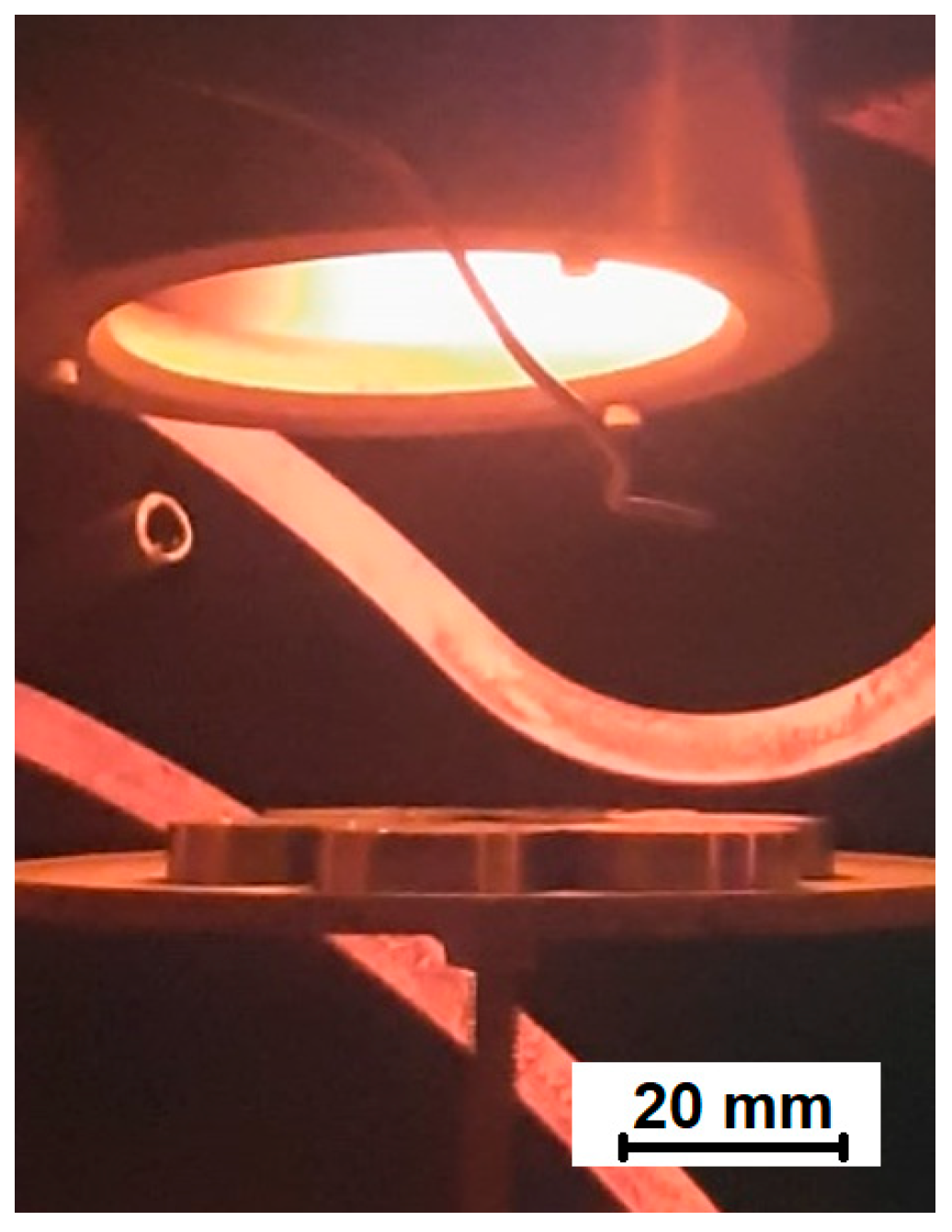
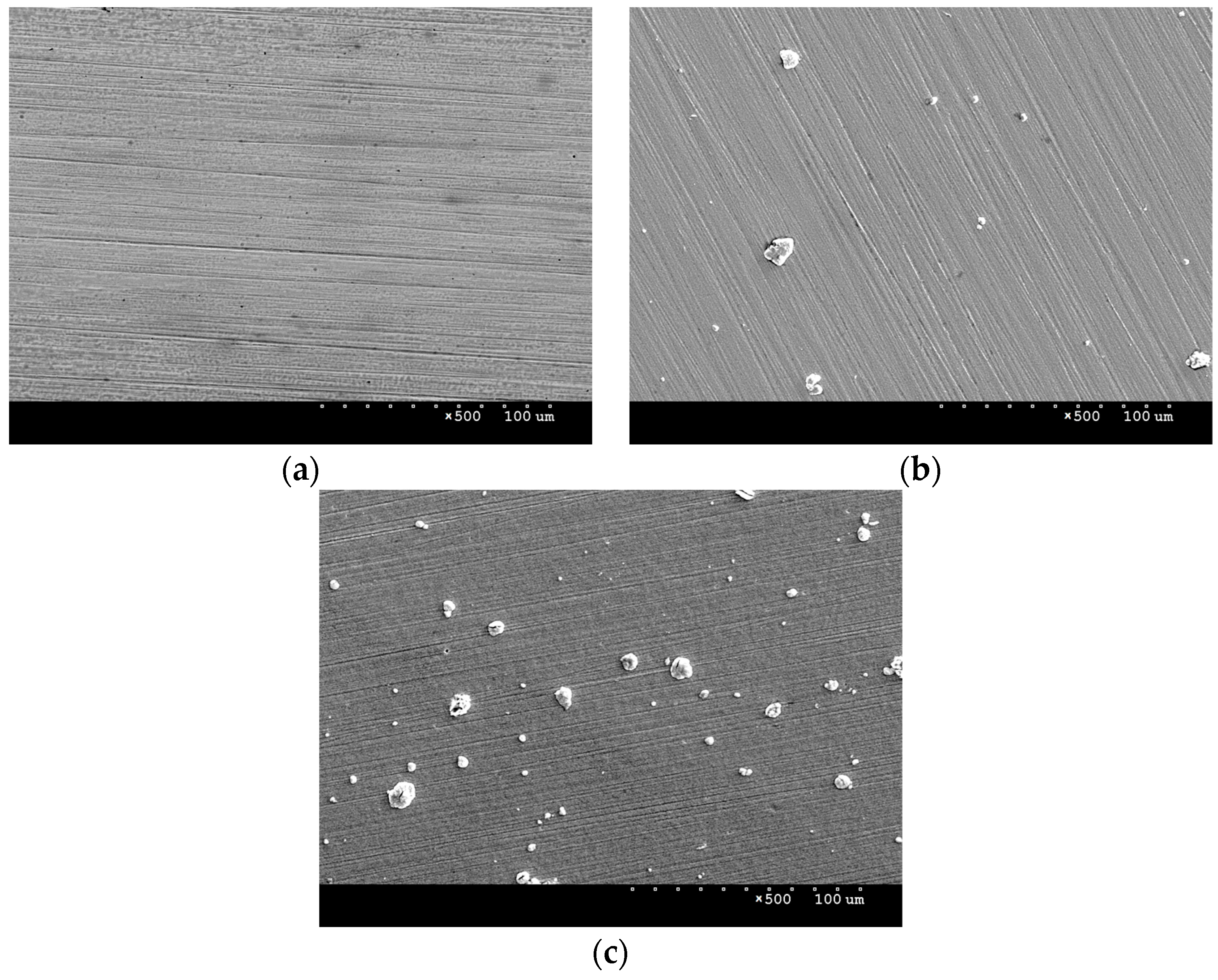
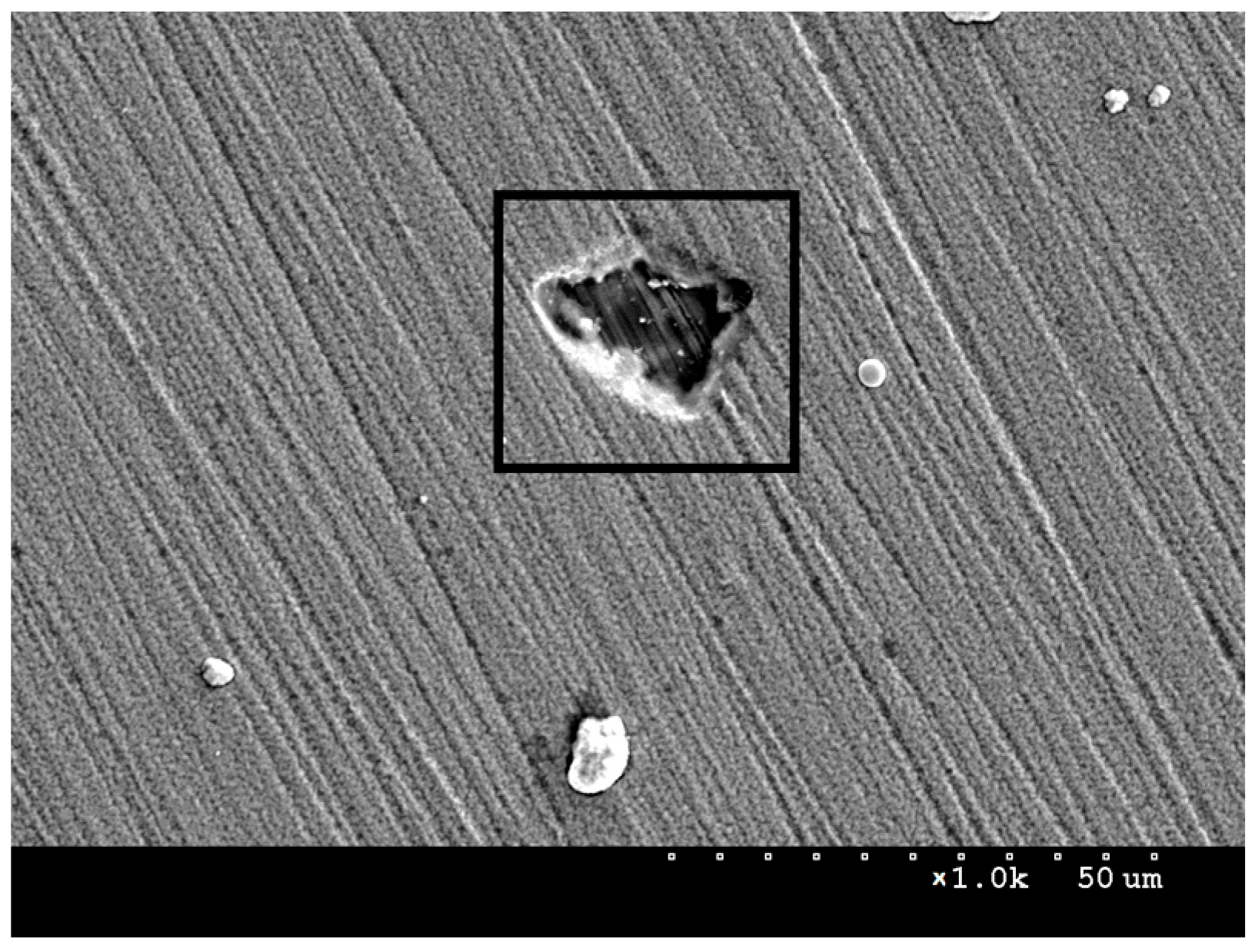
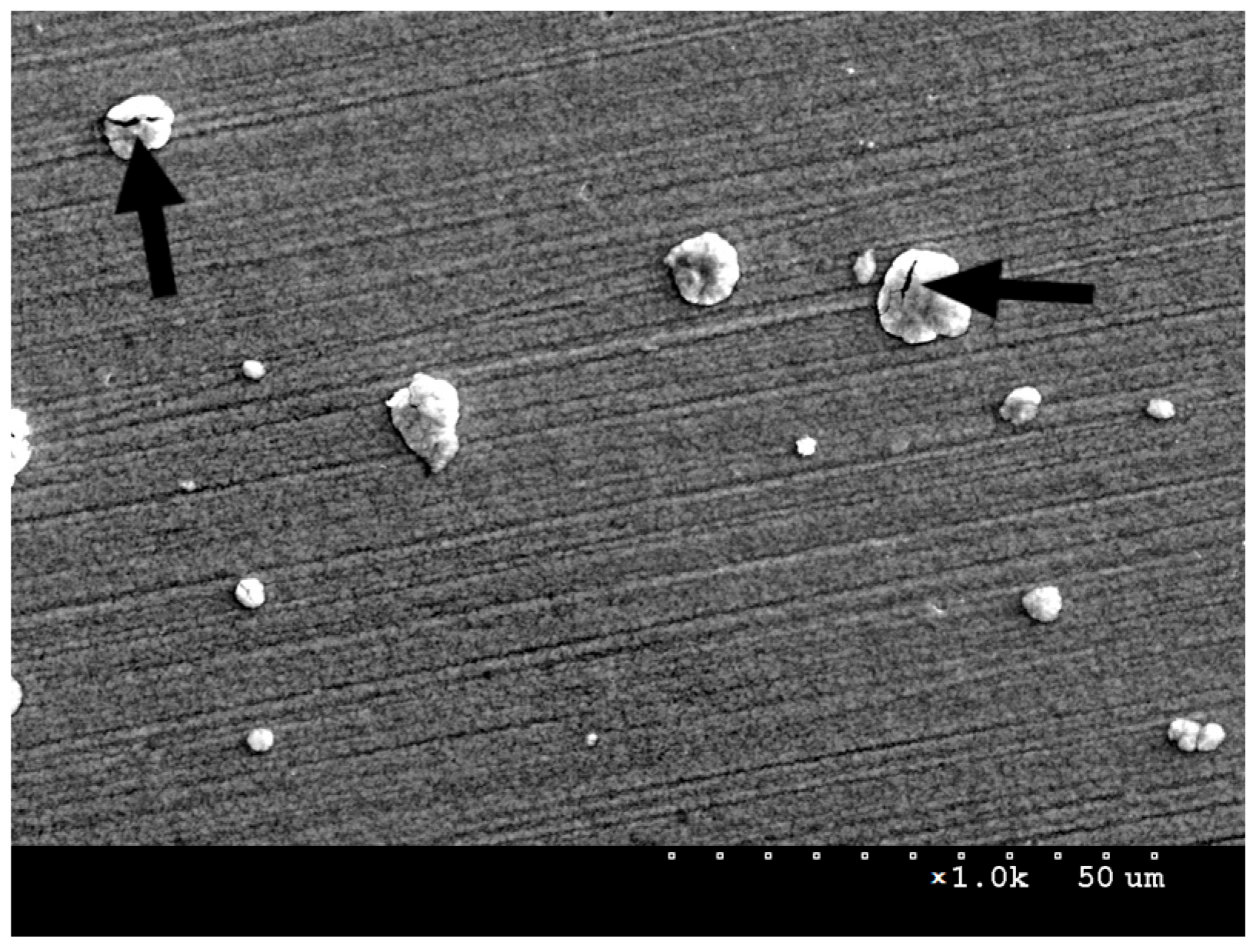
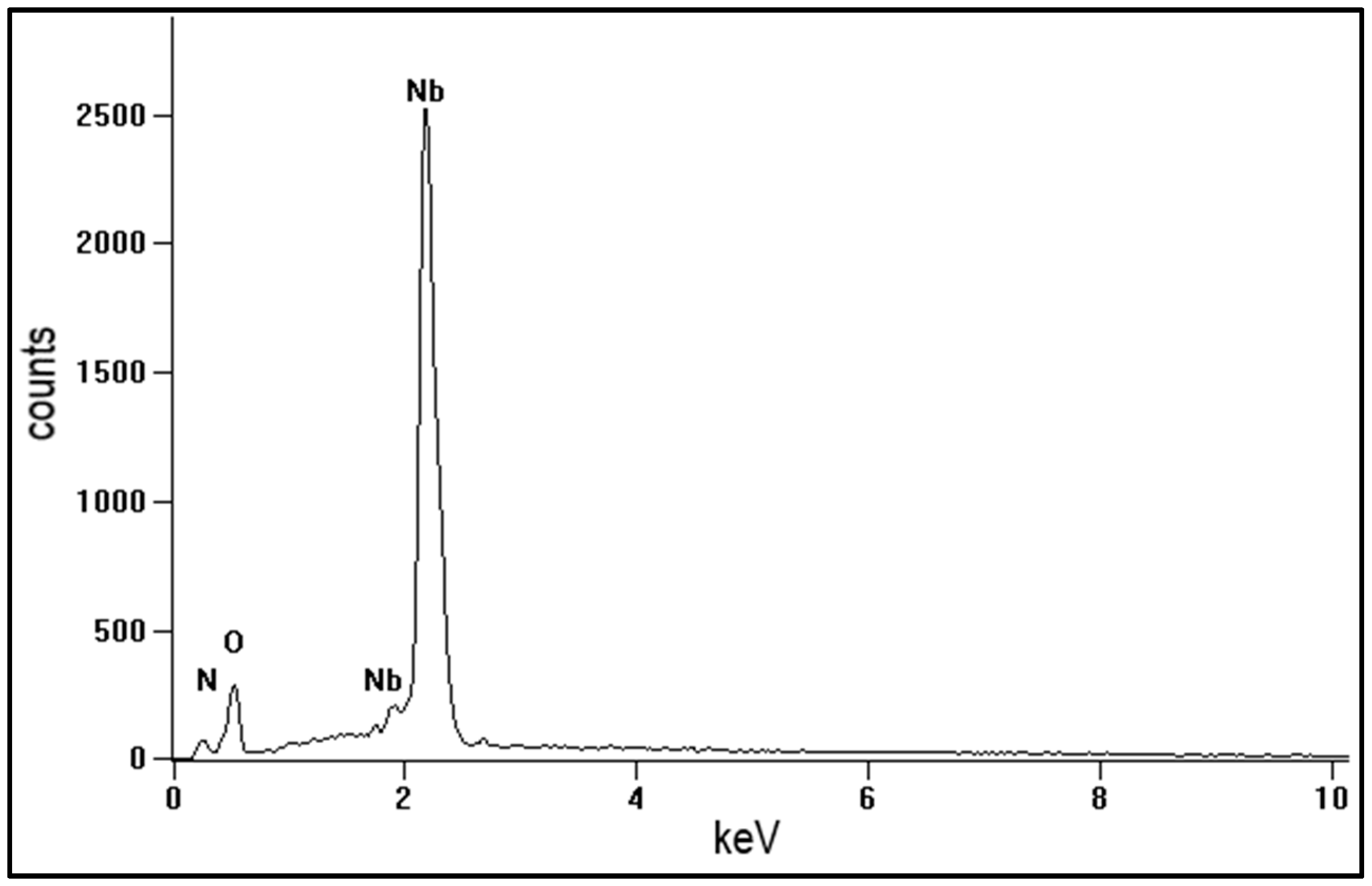
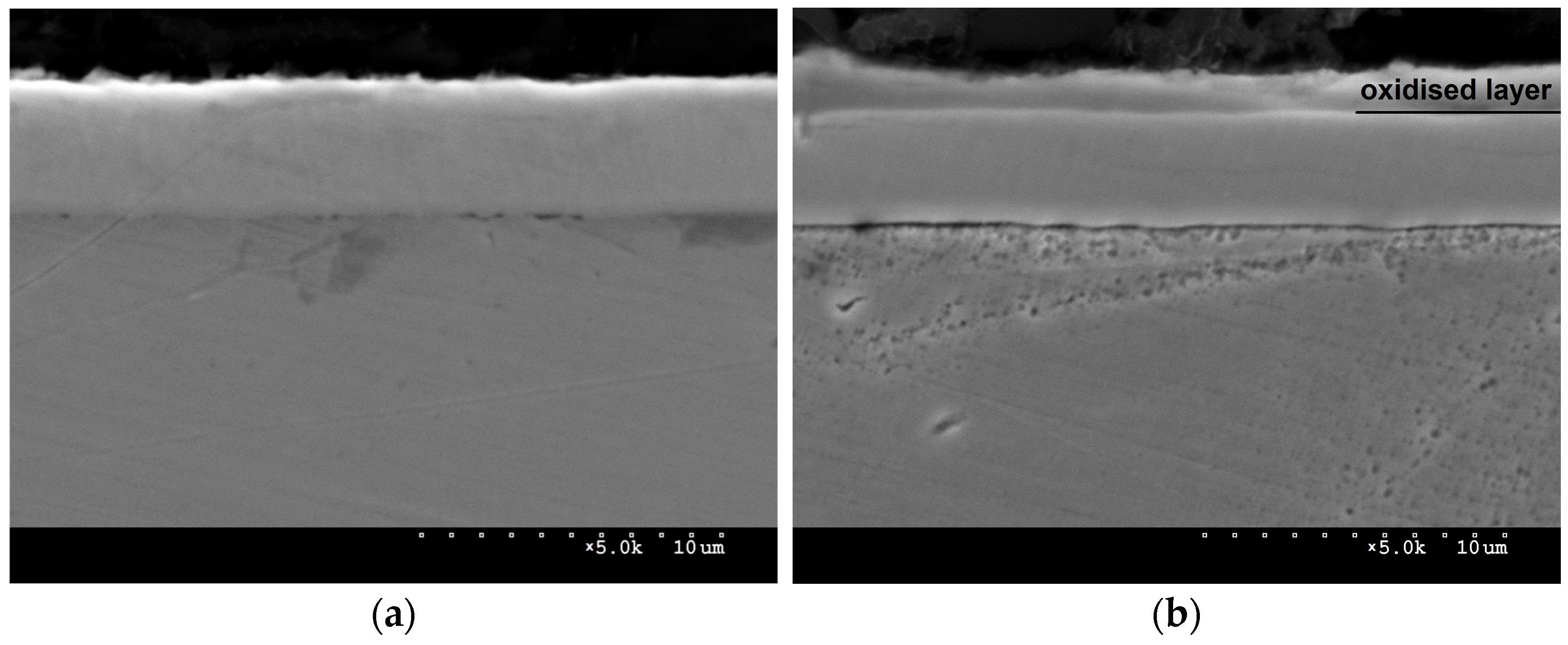
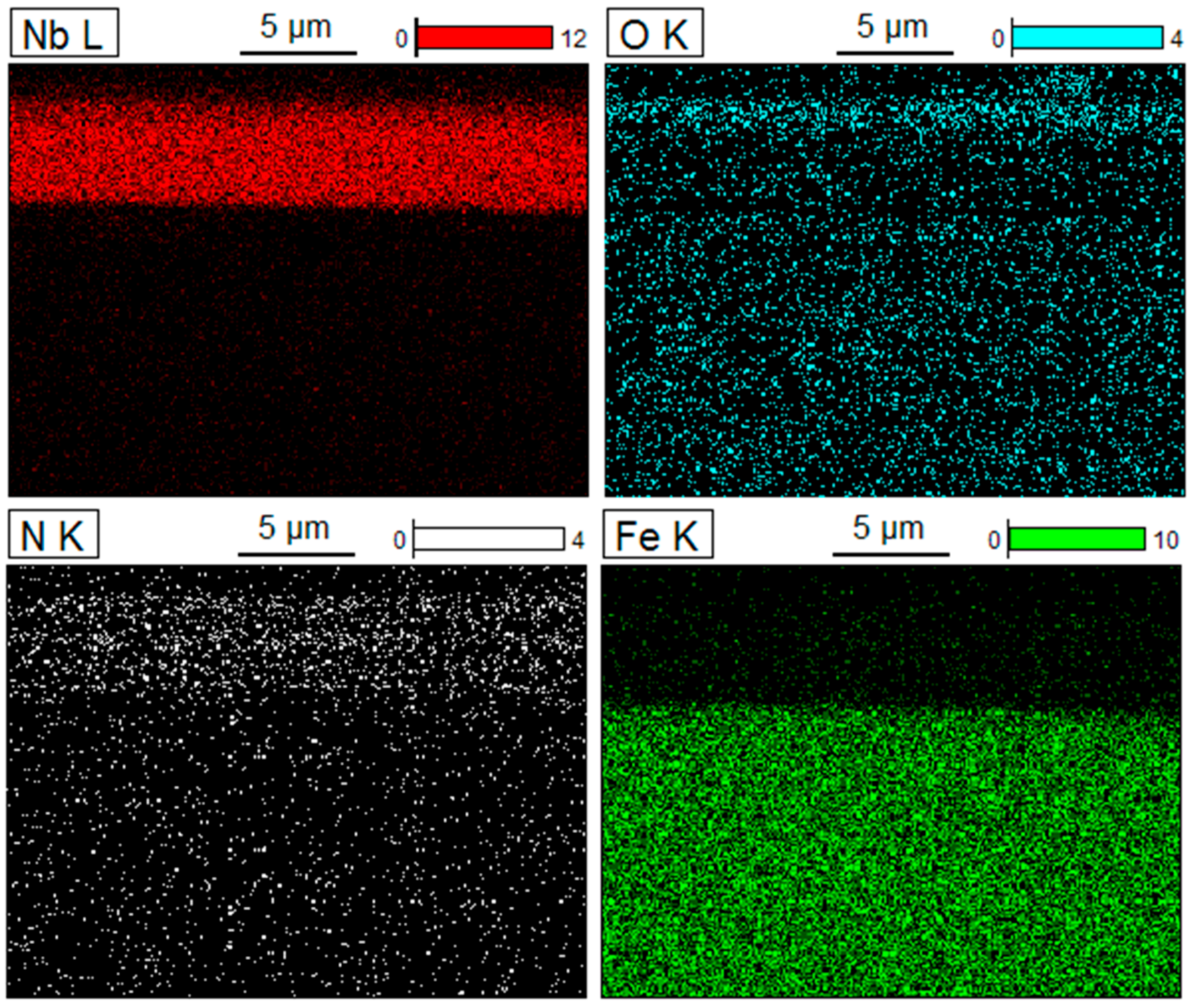
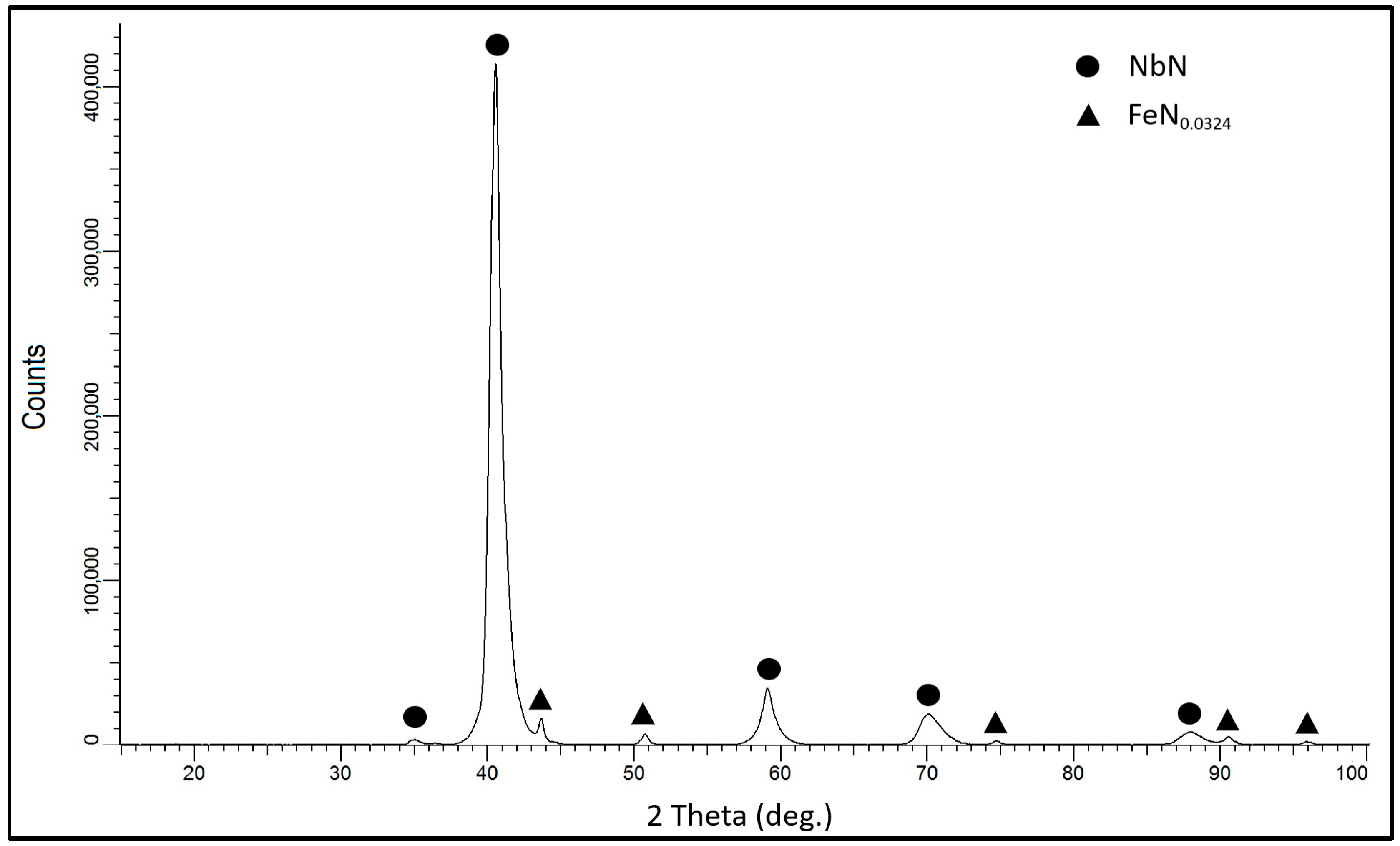
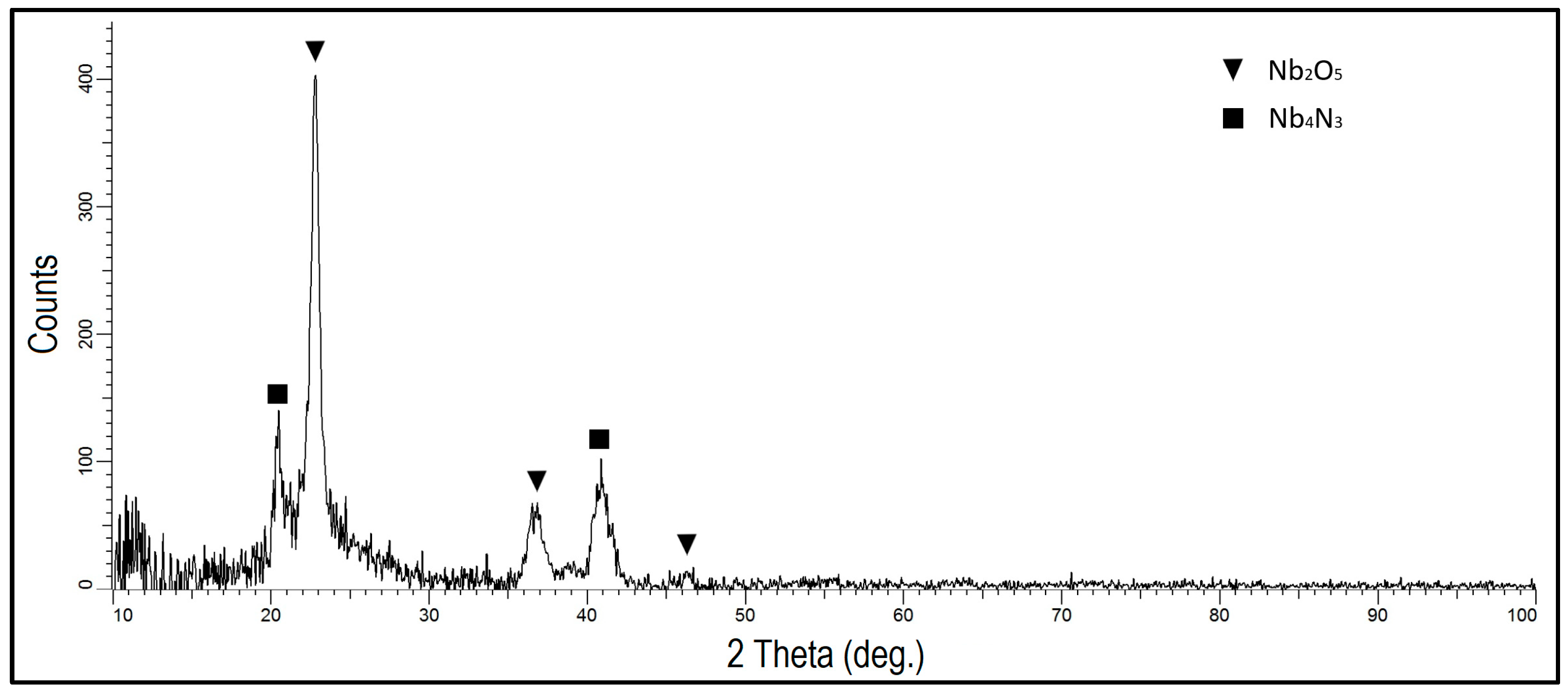
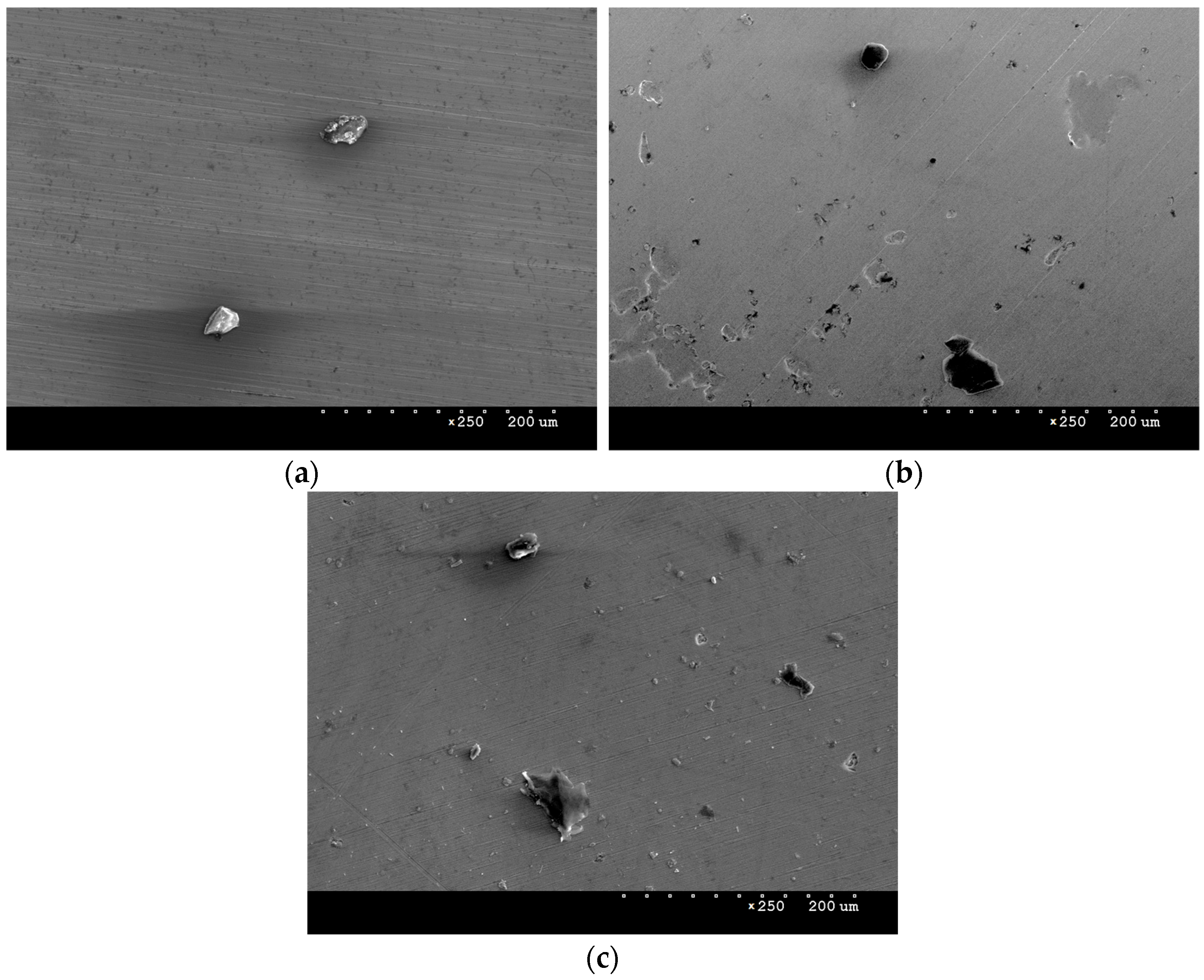

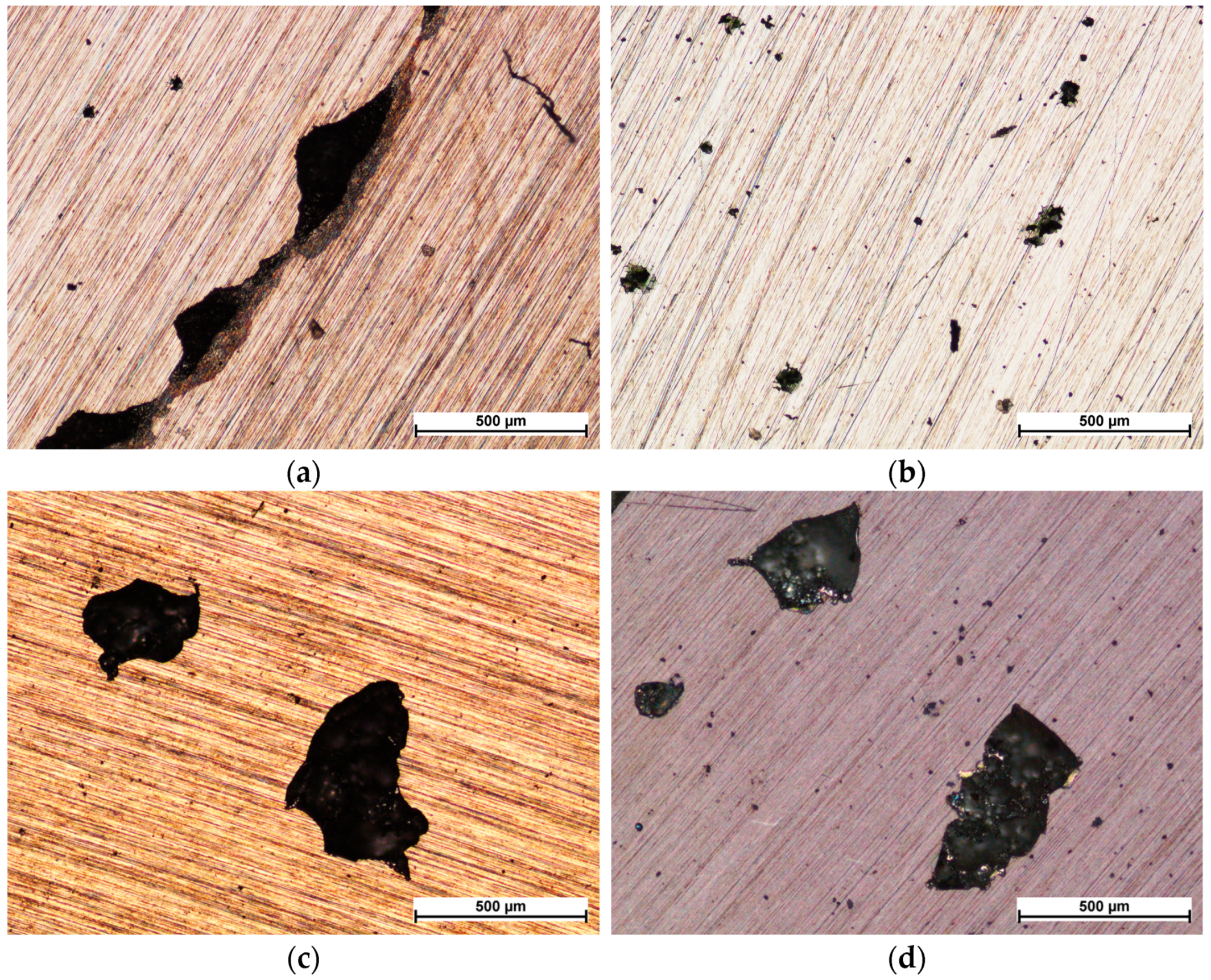

| Examined Area | N | O | Nb |
|---|---|---|---|
| Weight % | |||
| Agglomerates | 2.1 ± 0.3 | 19.4 ± 2.1 | 78.5 ± 2.0 |
| Flat surface | 3.1 ± 0.1 | 15.5 ± 0.5 | 81.4 ± 0.5 |
| Atomic % | |||
| Agglomerates | 7.0 ± 1.1 | 54.3 ± 3.6 | 38.7 ± 2.9 |
| Flat surface | 10.7 ± 0.2 | 46.9 ± 0.8 | 42.4 ± 0.8 |
| Sample | Ra [nm] | Rt [nm] |
|---|---|---|
| AISI 316L | 52 ± 1.3 | 1340 ± 49.9 |
| NbN | 108.6 ± 3.7 | 11,416.7 ± 775.4 |
| NbN + oxidising | 489.5 ± 12.3 | 17,146.7 ± 1507.8 |
| AISI 316L | NbN | NbN + Nb2O5 | |
|---|---|---|---|
| HV0.1 | 290 ± 4 | 1046 ± 20 | 571 ± 10 |
| HV0.05 | 296 ± 5 | 2256 ± 37 | 852 ± 10 |
| Na [%] | Mg [%] | P [%] | Cl [%] | K [%] | Ca [%] | Ca/P | |
|---|---|---|---|---|---|---|---|
| AISI 316L | 0.11 ± 0.03 | 0.43 ± 0.12 | 1.80 ± 0.16 | 0.16 ± 0.05 | 0.06 ± 0.02 | 2.16 ± 0.19 | 1.20 |
| NbN | 0.06 ± 0.01 | 0.45 ± 0.13 | 1.30 ± 0.43 | 0.22 ± 0.07 | 0.03 ± 0.01 | 2.24 ± 0.25 | 1.73 |
| NbN + Nb2O5 | 0.91 ± 0.21 | 0.45 ± 0.13 | 1.22 ± 0.36 | 0.61 ± 0.18 | 0.61 ± 0.15 | 2.17 ± 0.25 | 1.77 |
| Sample | Ecorr [mV] | icorr [A·cm2] | Rpol [Ω·cm2] | Ipass * [A/cm2] | Epit [mV] |
|---|---|---|---|---|---|
| AISI 316L | −34.6 ± 10.9 | 2.55·10−7 ± 9.7·10−8 | 1.97·105 ± 4.56·104 | 5.5·10−6 ± 1.68·10−6 | 243 ± 15 |
| NbN | 10.8 ± 5.8 | 2.48·10−7 ± 6.73·10−8 | 3.04·105 ± 4.95·104 | 5.18·10−7 ± 2.35·10−7 | 463 ± 38 |
| NbN + Nb2O5 | −20.8 ± 40.3 | 6.16·10−9 ± 1.93·10−9 | 3.10·106 ± 5.90·105 | 7.29·10−9 ± 2.56·10−9 | 458 ± 12 |
| Sample | AISI 316L | NbN | NbN + Nb2O5 |
|---|---|---|---|
| Contact angle θ [°] | 62.7 ± 1.9 | 70.5 ± 1.6 | 58.8 ± 1.3 |
Disclaimer/Publisher’s Note: The statements, opinions and data contained in all publications are solely those of the individual author(s) and contributor(s) and not of MDPI and/or the editor(s). MDPI and/or the editor(s) disclaim responsibility for any injury to people or property resulting from any ideas, methods, instructions or products referred to in the content. |
© 2023 by the authors. Licensee MDPI, Basel, Switzerland. This article is an open access article distributed under the terms and conditions of the Creative Commons Attribution (CC BY) license (https://creativecommons.org/licenses/by/4.0/).
Share and Cite
Borowski, T.; Rospondek, J.; Betiuk, M.; Adamczyk-Cieślak, B.; Spychalski, M. Influence of Magnetron Sputtering-Deposited Niobium Nitride Coating and Its Thermal Oxidation on the Properties of AISI 316L Steel in Terms of Its Medical Applications. Materials 2023, 16, 6890. https://doi.org/10.3390/ma16216890
Borowski T, Rospondek J, Betiuk M, Adamczyk-Cieślak B, Spychalski M. Influence of Magnetron Sputtering-Deposited Niobium Nitride Coating and Its Thermal Oxidation on the Properties of AISI 316L Steel in Terms of Its Medical Applications. Materials. 2023; 16(21):6890. https://doi.org/10.3390/ma16216890
Chicago/Turabian StyleBorowski, Tomasz, Justyna Rospondek, Marek Betiuk, Bogusława Adamczyk-Cieślak, and Maciej Spychalski. 2023. "Influence of Magnetron Sputtering-Deposited Niobium Nitride Coating and Its Thermal Oxidation on the Properties of AISI 316L Steel in Terms of Its Medical Applications" Materials 16, no. 21: 6890. https://doi.org/10.3390/ma16216890
APA StyleBorowski, T., Rospondek, J., Betiuk, M., Adamczyk-Cieślak, B., & Spychalski, M. (2023). Influence of Magnetron Sputtering-Deposited Niobium Nitride Coating and Its Thermal Oxidation on the Properties of AISI 316L Steel in Terms of Its Medical Applications. Materials, 16(21), 6890. https://doi.org/10.3390/ma16216890







